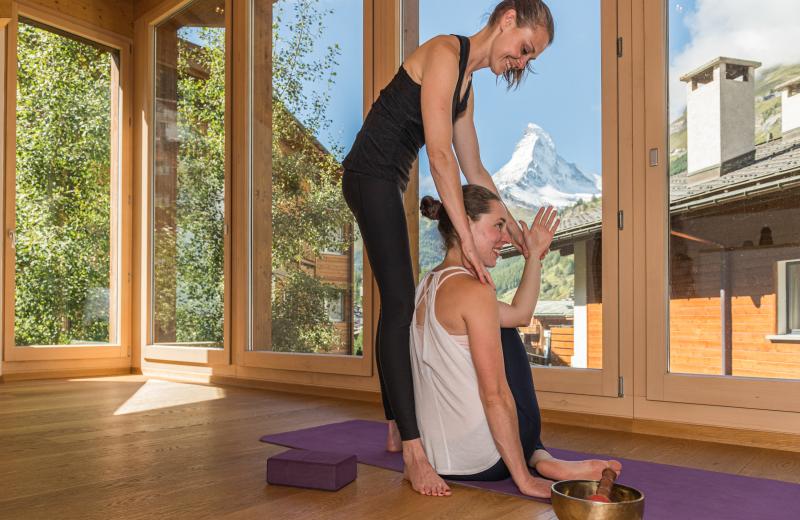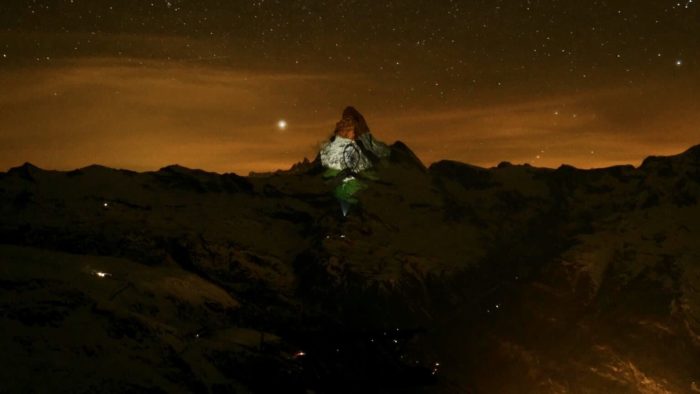More than century ago, one of India's brightest lights - Swami Vivekananda visited Zermatt while on a tour of Europe in 1896. In her book Swami Vivekananda in The West (Volume 4) Marie Louise Burke, writes;
Indeed, we know that Swamiji picked alpine flowers on the glacier of Monte Rosa (glacier near Matterhorn, approximately 12 km from it)… One of these small flowers he sent in a letter to his disciple Kripananda. "I went to the glacier of Monte Rosa yesterday, he wrote, " and gathered a few hardy flowers growing almost in the midst of eternal snow. I send you one in this letter hoping that you will attain a spiritual hardihood amidst all the snow and ice of this earthly life..."
The Indian tri-colour lit up Mount Matterhorn on April 18, in a beautiful Alpine display of hope across continents.
Switzerland has been lighting up the Matterhorn every day, since Tuesday, March 2020, with the help of light artist Gerry Hofstetter.
Not the highest mountain in the world at 14,600ft, the Matterhorn which means ‘peak in the meadows” in German, straddles the Swiss-Italian border, and has been on every climber’s bucket wish list, a little after Mount Everest and K2.
With the illumination, Zermatt wants to give people a sign of hope and solidarity in this difficult time of the Coronavirus pandemic, as its motto suggests – “Light is hope". “The village shows solidarity with all people who are currently suffering and is grateful to all those who are helping to overcome the crisis. This includes the medical staff, all those who ensure the logistics and the supply of the population as well as all those who stay at home out of consideration and adapt their daily routine and tasks to the circumstances,” adds the press release.
On April 18, World Heritage Day, the mountain shows how much the world has shrunk. Zermatt in Switzerland shines the Indian tri-colour publicly today, but for days, perhaps years, the light of Yoga and Ayurveda have been shining in the Alps.
The Swiss government in 2015 recognised and sanctioned Ayurveda medicine and therapy, making it the first Western country to do so.
The Indo-Swiss Ayurveda Foundation (ISA) has given the Swiss authorities a list of 450 formulations which are being included in the curriculum for the examinations which will be held for medical practitioners in Switzerland.
The first batch of Ayurveda practitioners graduated in 2018 and after their internship became the first to practice Ayurveda in Switzerland in 2019. To appear for the examinations, trained candidates were coached in Coimbatore.
Stefanie a yoga practitioner in Zermatt says Yoga for her is a “philosophy of life that allows me to access myself…to recognize and live beauty with attentiveness and gratitude in the here and now. It is a school of life that teaches me again and again to listen to myself, my body and my environment.”

She says that the “fascination of what asanas (physical exercises), pranayama (breathing exercises) and meditation can do for body and mind finally led me to India, the country of origin of Yoga. I soon realized that I wanted to pass on this knowledge and enthusiasm.”
For Stefanie, her yoga classes are “like life itself, sometimes calm, sometimes playful, sometimes challenging and always with a smile.”

Switzerland has been home to a large number of Hindus in the last two decades. The first temple was built in 2013 at Trimbach—about halfway between Zurich and Basel. The year before, the city of Lucerne granted permission for Hindus to perform their own burial rites allowing them to immerse ashes at a spot at the Reuss River.
The Indian flag on the mountain has symbolically become a prayer flag in itself, carrying in itself the sutra of hope.





